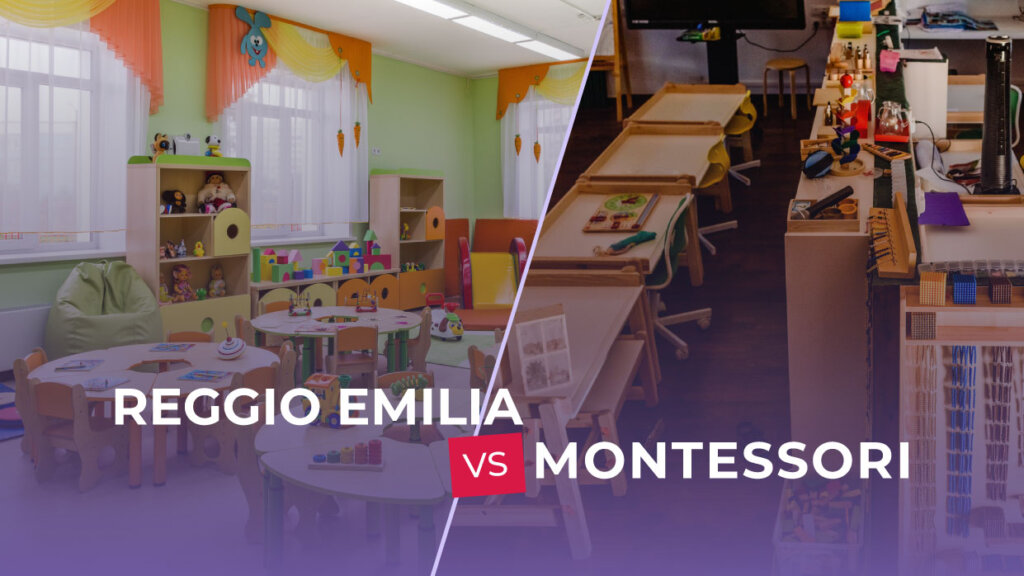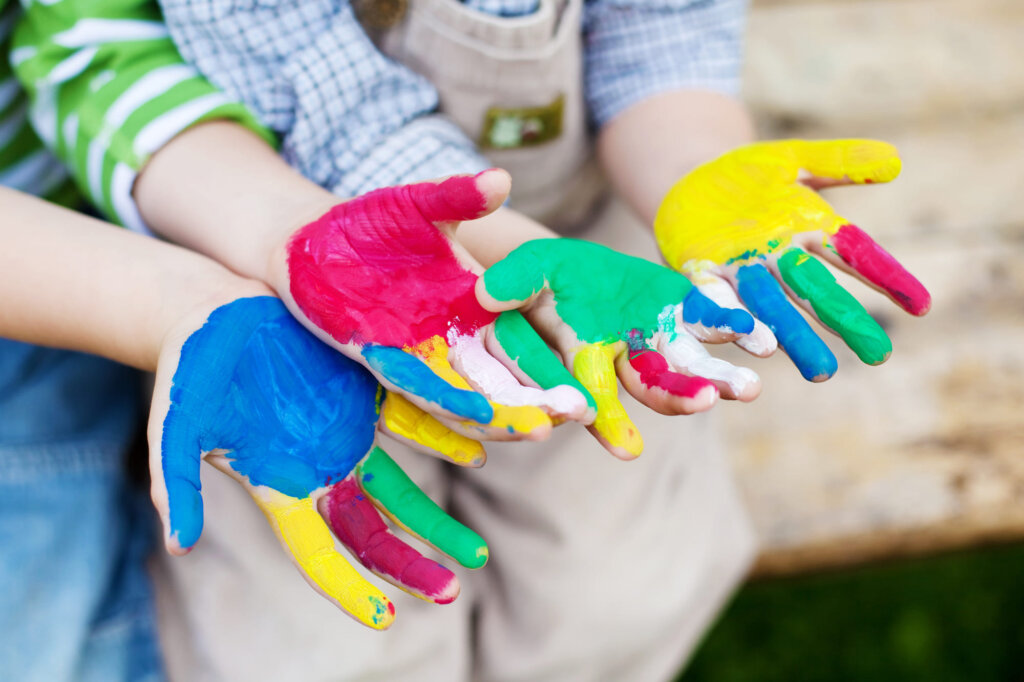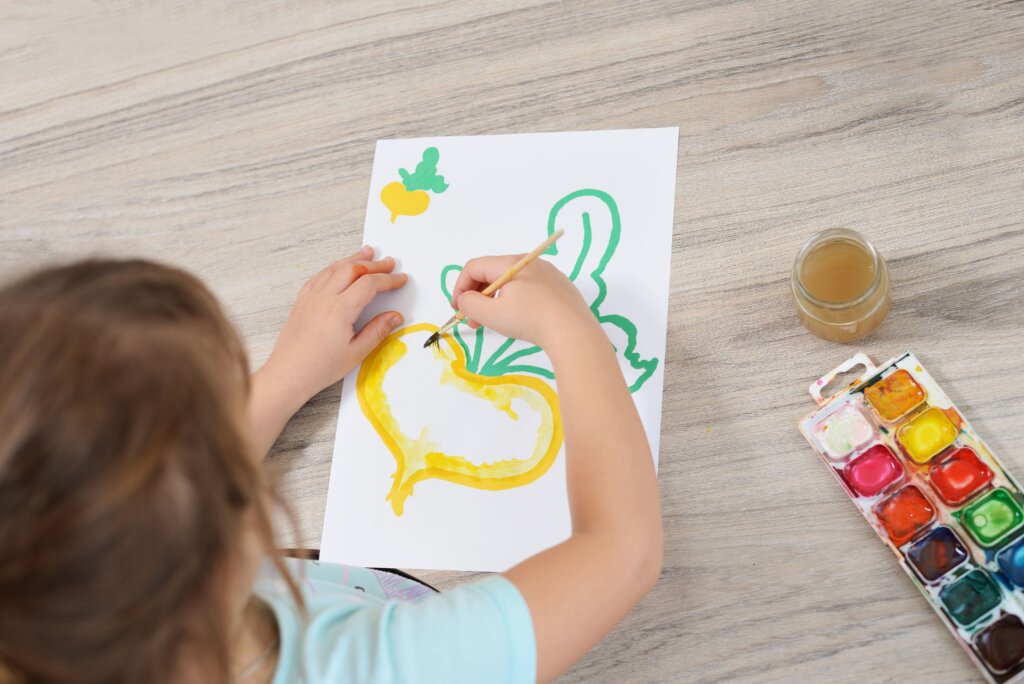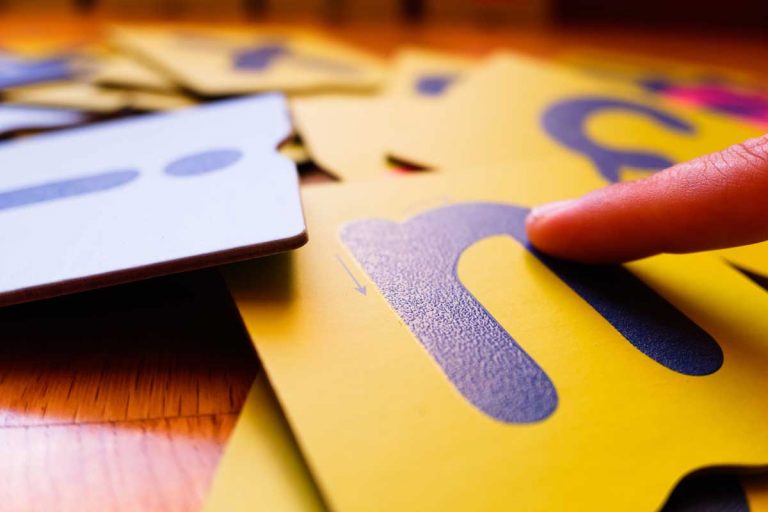Both the Reggio Emilia and Montessori educational philosophies are becoming more popular and recognized throughout the USA, UK, Canada and Australia. After delving deep into the word of Montessori, I started noticing and reading bits and pieces of information around Reggio Emilia…and found myself wondering – how they actually compare? I’ve done some (well… a lot of) research, and here’s what I’ve learnt when comparing two notable approaches to early childhood education.
As parents and educators it’s important for us to understand the differences and similarities between these two approaches so that we can make informed decisions about the best learning environment for our little ones and which approach will better suit our individual families.
So let’s take a look at my comparison of the Reggio Emilia and Montessori educational philosophies so that we can both get better grasp of what each one is all about!
What is the Reggio Emilia approach?
History and Influences and Origins of Reggio Emilia

In the early 1950s, following World War II’s conclusion, Loris Malaguzzi, an Italian psychologist, collaborated with a group of parents from Villa Cella, near the city in Northern Italy – Reggio Emilia.
They developed this learning philosophy to create respectful, responsible citizens and to enrich the children’s lives born into war.
Key Principles
The Reggio Emilia approach has the following key principles:
- Same age groups: Children of the same age are grouped and educated.
- Relationships: Highly valuing relationships with peers, teachers, family, the entire community, and the environment, parents, and other community members are often invited into Reggio Emilia classrooms.
- Interactions: Children are motivated to work in groups and learn through social collaboration, developing knowledge by communicating with others.
- Project-based learning: Children’s curiosity and questions lead to the teacher initiating projects that allow for naturally-evolved learning.
- Self-guided, collaborative learning: The lessons are planned to be adaptable and flexible, with students encouraged to steer towards subjects of interest.
- Children have many languages: Children explore the various aspects of communication through speech, art, and play.
Children as active participants in their learning
Reggio education believes that children are capable and competent learners – something that really speaks to me and draws me towards the Reggio approach. If you find yourself in a Reggio Emilia educational setting, you’ll likely notice that the little ones are actively involved in their own learning. They’re probably not going to be sitting still listening to the teacher, but rather exploring, experimenting and finding their own forms of expression.
The environment as the “third teacher”
Something I love about Reggio Emilia is that environment is considered the “third teacher.” So this means that the physical classroom is carefully designed to inspire curiosity, creativity and wonder. Within the environment you’ll find natural materials and cozy reading nooks. Everything is thoughtfully set out to support the learning and exploration of little ones.
The role of documentation
Another interesting thing about Reggio Emilia is the importance of documentation! Teachers in Reggio Emilia environments will regularly document a child’s learning experience via photos, videos, and notes. Why? It helps educators understand each child’s progress while also giving parents insights into their child’s learning journey. Our day-care center is Reggio-aligned (I’m working on a post about why we chose a Reggio daycare!) and one of my favorite things is the updates that they provide each day where we can see our son’s learning and development.
Collaboration and co-construction of knowledge
Once I started learning about Reggio Emilia, I loved the emphasis that is placed on collaboration and co-construction of knowledge. This means that children, teachers, and their parents work together to explore ideas and solve problems. This collaborative spirit fosters a sense of community and helps children develop important social skills.
The Hundred Languages of Children
Central to the Reggio Emilia approach, the concept of the “Hundred Languages of Children,” acknowledges all the ways children express themselves. This includes their thoughts, feelings, and ideas. Expression is encouraged via many methods – like art, music, dance or storytelling. Reggio Emilia schools support little ones explore and communicate using a wide range of languages.
What Is the Montessori Approach?
History and Influences and Origins of the Montessori Method
Montessori schools use a child-led approach to education, extending beyond preschool to elementary and even middle school levels. It involves hands-on learning, self-directed activities, practical life skills, and sensory experiences.
Montessori schools use structured learning tools, sensory materials, and discovery-based activities. The materials are arranged in a structured manner on low, open shelves. Montessori classrooms are typically quiet and organized, with specific learning areas and materials for children to use independently.
“Play is the work of the child” is the Montessori approach.
The Montessori philosophy was founded by the physician and educator Dr. Maria Montessori in the first half of the 20th century.
In 1907, she opened her first school in Rome, Casa Dei Bambini (Children’s House). It was intended to offer quality education to the underprivileged children of San Lorenzo. Children were encouraged to explore and learn from their surroundings.
Key Principles
The key principles of Montessori education include:
- Mixed-age groups: A Montessori classroom has mixed-age groups spanning three years. Younger children observe and learn from older children, who, in turn, can take care of the younger ones and help them out.
- Hands-on learning: Self-corrective learning tools help the children learn better with the hands-on learning process. Children can make errors, revisit and work out the correct methods.
- Focus on the whole child: Apart from the academic learning aspect, practical skills are also essential in the Montessori curriculum, including behaving politely and respecting others.
- Uninterrupted work time: Children can spend extended periods working on the project of their choice and can move around and choose their activities. It instills independence and sensory stimulation in them based on general day-to-day activities.
- Self-guided learning: In Montessori learning, children are given the freedom to choose their activities and encouraged to learn naturally through play-based learning.
The child as an independent learner
Something that drew me to the Montessori approach is its focus on nurturing children as independent learners. In Montessori schools, kids are encouraged to make choices, take responsibility for their actions, and learn at their own pace. The Montessori Method is carefully considered and designed to ensure children develop a sense of autonomy and self-confidence.
The prepared environment
Montessori classrooms are purposefully organized to support children’s learning and development – from layout of the furniture to how materials presented to children – everything designed to be inviting, accessible, and purposeful. I think that one of the most important things we can do as carers and parents is to make sure we offer a prepared environment to our little ones. A prepared environment gives our children a framework to work within and thrive.
The role of the Montessori materials
Montessori toys, technically known as materials, are often of the first things that I find leads parents towards learning about the Montessori Method. It’s important to understand that Montessori materials are very different to Montessori-friendly and Montessori-inspired toys. Montessori materials are carefully designed tools developed by Dr. Montessori herself. They are hands-on learning tools that form an essential part of the Montessori educational curriculum. Each material is designed to be self-correcting, allowing children to learn from their mistakes and grow in independence. They are also designed to focus on a specific skill or ability, promoting concentration.
Sensitive periods and the absorbent mind
If you’ve started to dive deeping into learning anout the Montessori Method, you have probably heard of the concepts of sensitive periods and the absorbent mind. If not, I’ve written a post about it here, where you can learn more. But to put it succinctly, the Montessori approach recognises several distinct developmental phases that little ones progress through. These phases are known as planes of development. Children are are particularly receptive to learning specific skills during the various planes. I remember when I first read about the sensitive periods, my mind was B-L-O-W-N – it all made so much sense! I now try to recognize and respond to these sensitive periods so I can better support my son’s natural curiosity and eagerness to learn.
Lesson Examples
There are considerable differences in how a lesson looks in Reggio Emilia vs. Montessori classrooms.
What Does a Montessori School Lesson Look Like?
A Montessori classroom environment encourages students to explore self-directed learning.
Montessori toys, sensory materials, and learning and discovery-based activities are used in Montessori schools. The materials are arranged in a structured manner on low, open shelves.

Montessori schools have multiple well-organized stations for different subject areas – cooking, gardening, library corner, etc. Children can move around instead of staying at their desks.
For a lesson on language, one station may incorporate kinesthetic learning, using letters made of sandpaper to form words. Cut-out letters may also be included for manipulation by children into words and sounds. Also, books focusing on age-appropriate phonetics or rhyming might be present.
Another station for spoken language will include artwork and books for discussing the parts as a whole and the meaning. It will also include sound games, song lyrics, and poems. Another station will include many phonetic activities to help with language learning.
What Does a Reggio School Lesson Look Like?
Reggio Emilia schools or Reggio-inspired schools are based on providing children access to 100 Languages. It’s based on the assumption that children have 100 languages, including the language of play, song, dance, art, laughter, and more, used to understand the world.
Classrooms, considered the third teacher, have a wide variety of materials to encourage creative learning and expression. There is no set curriculum; instead, the teachers talk to the students about their interests or observe them and then support children to explore the topic of their interests.
The classroom setup reflects the children, families, and local community’s context and culture. Learning is made visible with displays of children’s artwork and projects. Children have easy access to all learning materials in Reggio schools.
Activities in different modes (kinesthetic, audio, visual) provide children with learning opportunities using the many forms of 100 languages.
Similarities Between Reggio Emilia and Montessori
Both approaches place a strong emphasis on child-centered learning
Both methods keep the needs, interests and abilities of each child at their heart. I love how both philosophies celebrate the unique qualities of every child and support their innate curiosity.
The physical space is thoughtfully designed to support children’s learning and exploration
Another similarity is the importance both approaches place on the learning environment. Reggio Emilia sees the environment as the “third teacher,” while Montessori focuses on the “prepared environment.” In both cases the aim is design an environment that fosters independence and a love for learning.
Children are seen as unique, competent individuals with their own strengths and interests
Something that stood out to me when comparing Reggio Emilia and Montessori is the respect both approaches have for the child’s individuality. The learning experience is tailored to each child, rather than a one-size-fits-all mould.
Children learn important skills social-emotional skills (like empathy, cooperation and problem-solving)
Both Reggio Emilia and Montessori share a strong focus on social-emotional development. In both approaches, interactions with their peers, teachers and the environment play an important part. Both methods believe in nurturing the whole child, not just their academic abilities.
Differences Between Reggio Emilia and Montessori
The role of the teacher is very different
One of the most notable differences between the two approaches is the role of the teacher. A teacher in a Reggio environment aims to facilitation. They’ll guide children through their day through collaboration. On the other hand, the Montessori teacher aims direct then observe. They’ll introduce a materials, but then step back to allow the child to experiment alone, all while carefully observing the child to determine what material may be presented next.
Their approaches to curriculum design are contrasted
Another key difference is found in the curriculum and learning materials. Reggio Emilia doesn’t follow a fixed curriculum. Rather, projects and activities within a Reggio environment are inspired by children’s interests and ideas, known as an emergent curriculum. Montessori classrooms have a structured curriculum with specific materials designed for each developmental stage. Children are still provided freedom, but it’s within a more set range of parameters.
Documentation is important in one, while observation is the focus in the other
In a Reggio Emilia setting documentation plays a central role in the learning process, as teachers capture children’s experiences and use them to guide future activities, and also to provide carers and parents with updates throughout the child’s day. Montessori takes a more informal approach to documentation. Teachers observe a child’s progress and make adjustments to support their individual needs.
A focus on structure versus more fluidity
The level of structure and routine also varies hugely between the two approaches. Reggio Emilia classrooms are fluid and flexible, allowing children to move between activities and projects based on their interests. Montessori classrooms have a more defined structure, with set periods for individual work, group activities, and outdoor play.
Comparison Table: Key Differences Between Reggio Emilia and Montessori
| Montessori | Reggio Emilia | |
| History | Established by Dr. Maria Montessori in Italy at the beginning of the 20th century | Establish by Loris Malaguzzi and a group of parents in Italy, in the mid-20th century |
| Age suitability | Children are involved from infancy through 18 years | Primarily designed for preschoolers and early elementary school, children aged 2 – 6 years are involved |
| Age range with classroom environments | Multi-age classrooms, with children, grouped 0-3 yrs, 3-6 yrs, 6-9 yrs, and 9-12 yrs | Children are sorted by the age of development |
| Curriculum Structure | Structured curriculum; involves practical life skills and sensory experiences | Flexible curriculum, with lessons that are child-focused and centered on students’ inquiries |
| Learning Style | Independent learning | Collaborative learning |
| Arts | Focus more on academics than arts | More geared towards pre-school aged kids; a lot of attention to arts |
| Academics | More focus on academics; emphasize work over play | Open-ended curriculum leading to long-term, open-ended projects to suit children’s interests |
| Technology | Minimal use of modern-day technology, including computers, interactive whiteboards, tablets, etc. | Quite a bit of technology is used, including cameras and video recorders for observation and documentation |
| Role of teacher | Observe, guide, supervise, and assess children | Observe, listen, document, and reflect |
| Training of teachers | A credentialed Montessori teacher leads the class | No formal teacher training, credentialing, and authorization process |
| Availability | About 3,000 Montessori schools in the U.S. | About 1,200 Reggio Emilia-inspired schools |
| Affordability | The fee structure for Montessori schools ranges from $12,000 – $15,000 and varies based on the type of school (public, private, or charter) | The fee structure for Reggio preschools and daycares cost about $8,000 – $10,300 |
Choosing the Right Approach for Your Child: Factors to Consider
Just like each child is individual, both methods have their own distinct qualities. A method that is right for one child may not suit another. I think it’s important to remember this when deciding on the approach you’d like to take with your child – weather that’s in their formal educational setting or at home. Here are some questions to consider when making your decision!
What is your child’s learning style and temperament?
Consider your child’s unique learning style and temperament. Where one child will thrive in a more structured environment, like Montessori, another might prefer the open-ended, project-based approach of Reggio Emilia. If you child is drawn to working independently, perhaps a Montessori environment is better suited. If they’re a social butterfly, the collaborative environment of a Reggio classroom may suit their personality better.
What are you family values and priorities?
Think about your family’s values and priorities. Is involvement and a strong sense of community important to you? Reggio Emilia might be more aligned with your values. Or do you value independence and self-direction in children? Then Montessori could be the better fit for your family.
Is there availability of schools and resources in your local area?
Don’t forget to consider the availability of schools and resources in your area. Depending on where you live, you might find more Montessori schools or more Reggio Emilia-inspired programs. Take a visit to the schools, meet the teachers, and get a sense of the learning environment. Fees and cost can also be a consideration. Montessori schools require specially trained teachers, and the materials are quite costly too. This means that you might find Montessori to be a more expensive option.
What are your long-term educational goals for your child?
Lastly, consider your long-term educational goals for your child. Do you see your child continuing with the same educational approach throughout their schooling, or are you open to a mix of different philosophies? Do you want the consistency of sticking with one approach, or do you see value in the diversity of experiences provided by exploring different educational paths.
There’s no one-size-fits-all answer when it comes to choosing between Reggio Emilia and Montessori. I hope these questions are helpful in guiding your decision-making process. Take the time to reflect on your child’s needs, your family’s values and the options available in your area to make the best decision for your little one!

The Bottom Line
Woah, that is a lot of information to take in, right? We’ve delved deeply into the worlds of Reggio Emilia and Montessori, explored their backgrounds, principles and some of their similarities and differences.
Montessori and Reggio Emilia are both educational approaches that put children at the center of their learning experience! While they share some similarities, they also have some key differences that make each approach unique.
In Montessori, children learn through a structured environment and materials designed to help them develop practical life skills, literacy, mathematics, and more. The teacher plays an important role in guiding the child’s learning and development.
In Reggio Emilia, children learn through exploration, collaboration, and social interaction. The teacher takes on more of a facilitator role, supporting children’s natural curiosity and interests.
Both approaches encourage children to learn at their own pace and follow their passions. However, Montessori has a more specific curriculum, while Reggio Emilia has a more flexible approach based on the child’s interests.
Montessori classrooms are typically quiet and organized, with specific learning areas and materials for children to use independently. Reggio Emilia classrooms are often more open and flexible, with an emphasis on natural light, colors, and materials to create a warm and welcoming environment.
Assessment in Montessori is often based on mastery of specific skills and knowledge, while Reggio Emilia focuses on the child’s ongoing learning process and exploration.
Overall, both Montessori and Reggio Emilia offer unique approaches to child-centered learning that can help children develop a love of learning and a sense of independence. So, whether you’re a Montessori mama or a Reggio Emilia enthusiast, there are plenty of ways to support your child’s growth and development!
As parents and educators, it’s important for us to make informed decisions when it comes to our children’s education. By understanding the nuances of different educational philosophies, you’re setting yourself up to better support your little one.
At the end of the day, there’s no one-size-fits-all answer when it comes to choosing the right educational approach for your child. By understanding the principles and values of Montessori and Reggio Emilia, you’ll be well-equipped to create a learning environment that supports your child’s unique abilities, interests, and potential.
And remember – at the heart of both Montessori and Reggio Emilia’s approaches is the belief in the incredible potential of each child. And if that’s all you take away from this comparison, then that alone makes my job a job well done!










